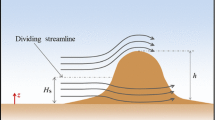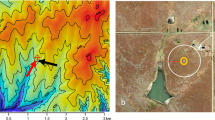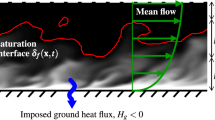Summary
Billows are the commonest form of hydrodynamic instability revealed by cloud motions in air that is stably stratified. A steady turbulent state does not exist in stably stratified fluids. Helmholtz instability can be interpreted as the accumulation of the vorticity of a vortex “sheet” into parallel rolls, whose spacing is determined by the thickness of the vortex layer. As a result of the mixing that occurs ultimately in the rolls, the vortex layer is transformed into a mixed layer of about five times its original thickness.
The instability is generated by the tilting of the stable layer and the most stable layers become the most unstable by this mechanism. The tilting most readily occurs in mountain waves and at fronts. The repeated rolling up of recently formed layers is the mechanism of clear air turbulence. Stable layers of small thickness originate in a variety of ways, such as at subsidence inversions and ttops of cloud layers. But they are also the natural result of large scale instability in airstreams with a vertical gradient of wind. This takes the form of very flat cellular motion in vertical planes transverse to the wind, and these cells have a width-height ratio of about 1000, and consequently have a small vertical thickness.
Zusammenfassung
Wogenwolken stellen die allgemeinste Form hydrodynamischer Instabilität dar, die von Wolkenbewegungen in stabil geschichteter Luft angezeigt wird. In Flüssigkeiten mit stabiler Schichtung existiert kein stationärer Turbulenzzustand. Die Helmholtzsche Instabilität kann als Akkumulation der Vorticity einer Wirbelschicht in parallelen Rollen interpretiert werden, deren Abstand voneinander durch die Dicke der Wirbelschicht bestimmt ist. Als ein Ergebnis der Mischungsvorgänge, die schließlich in den Rollen auftreten, wird die Wirbelschicht in eine durchmischte Schicht übergeführt, die etwa auf das Fünffache der ursprünglichen Dicke angewachsen ist.
Die Instabilität wird durch die Neigung der stabilen Schicht herbeigeführt. Durch diesen Mechanismus wird aus der ursprünglich stabilsten schicht nunmehr die instabilste. Eine Neigung der Schicht tritt vorzugsweise in Gebirgs-Leewellen und an Fronten auf. Ein wiederholtes Aufrollen der neu geformten Schichten stellt den Mechanismus für Clear-Air-Turbulenz (Turbulenz im wolkenfreien Raum) dar. Stabile Schichten von geringer Dicke kommen auf verschiedene Weise zustande, so z. B. an Absinkinversionen und an der Obergrenze von Wolkenschichten. Sie können jedoch auch das natürliche Resultat von großräumigen Instabilitäten sein, die in Luftströmungen mit vertikalen windscherungen auftreten. In diesem Fall tritt in solchen Schichten eine Bewegung in Form von sehr flachen Zellen in Vertikalebenen normal zur Windrichtung auf. Das Verhältnis der Breite zur Höhe in diesen Zellen beträgt etwa 1000. Demzufolge besitzen diese Zellen nur geringe, vertikale Ausdehnung.
Similar content being viewed by others
References
Scorer, R. S.: Billow clouds. Quart. J. R. Met. Soc.77, 235 (1951).
Scorer, R. S.: Theory of Airflow over Mountains III, Airstream Characteristics (esp. fig. 2). Quart. J. R. Met. Soc.80, 417 (1954).
Scorer, R. S.: Natural Aerodynamics, pp. 153–154 and 243–244. London: Pergamon, 1958.
Scorer, R. S.: Paper no. 7 in R. A. E. Symposium—Atmospheric Turbulence in Relation to Aircraft Operation. London: H. M. S. O., 1961.
Scorer, R. S.: A Colour Encyclopaedia of Clouds. Chapter 6—Billows. London: Pergamon, 1971 (in press).
Scorer, R. S., andH. Wexler: A Colour Guide to Clouds. Plates 32, 33. London: Pergamon, 1963.
Scorer, R. S., andH. Wexler: Cloud Studies in Colour. Plates 61–64, and fig. 9. London: Pergamon, 1968.
Thorpe, S. A.: A Method of Producing Shear Flow in a Stratified Fluid. J. Fluid Mech.32, 693 (1968).
Author information
Authors and Affiliations
Additional information
With 2 Figures
AGARD Conference Proceedings No. 48, Paper No. 2.
Rights and permissions
About this article
Cite this article
Scorer, R.S. The origins and forms of dynamic instability in clear air at high altitude. Arch. Met. Geoph. Biokl. A. 20, 1–12 (1971). https://doi.org/10.1007/BF02247744
Received:
Issue Date:
DOI: https://doi.org/10.1007/BF02247744




